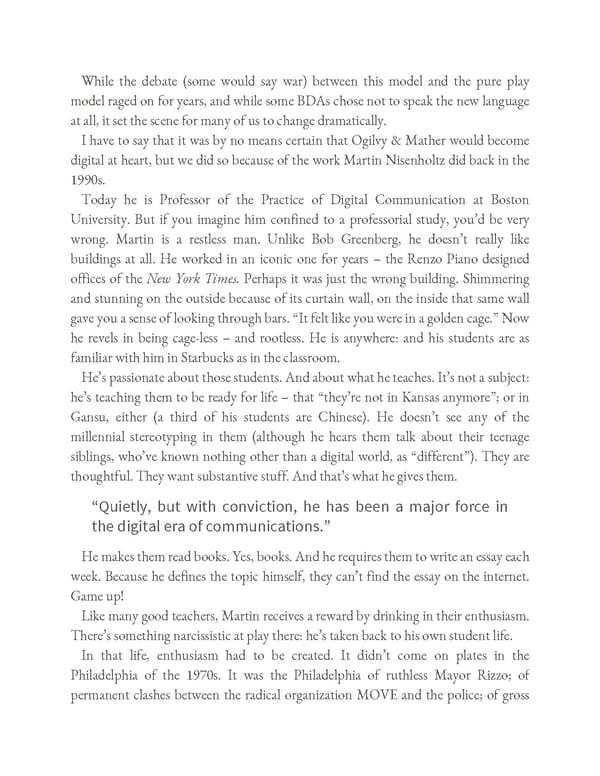While the debate (some would say war) between this model and the pure play model raged on for years, and while some BDAs chose not to speak the new language at all, it set the scene for many of us to change dramatically. I have to say that it was by no means certain that Ogilvy & Mather would become digital at heart, but we did so because of the work Martin Nisenholtz did back in the 1990s. Today he is Professor of the Practice of Digital Communication at Boston University. But if you imagine him confined to a professorial study, you’d be very wrong. Martin is a restless man. Unlike Bob Greenberg, he doesn’t really like buildings at all. He worked in an iconic one for years – the Renzo Piano designed offices of the New York Times. Perhaps it was just the wrong building. Shimmering and stunning on the outside because of its curtain wall, on the inside that same wall gave you a sense of looking through bars. “It felt like you were in a golden cage.” Now he revels in being cage-less – and rootless. He is anywhere: and his students are as familiar with him in Starbucks as in the classroom. He’s passionate about those students. And about what he teaches. It’s not a subject: he’s teaching them to be ready for life – that “they’re not in Kansas anymore”; or in Gansu, either (a third of his students are Chinese). He doesn’t see any of the millennial stereotyping in them (although he hears them talk about their teenage siblings, who’ve known nothing other than a digital world, as “different”). They are thoughtful. They want substantive stuff. And that’s what he gives them. “Quietly, but with conviction, he has been a major force in the digital era of communications.” He makes them read books. Yes, books. And he requires them to write an essay each week. Because he defines the topic himself, they can’t find the essay on the internet. Game up! Like many good teachers, Martin receives a reward by drinking in their enthusiasm. There’s something narcissistic at play there: he’s taken back to his own student life. In that life, enthusiasm had to be created. It didn’t come on plates in the Philadelphia of the 1970s. It was the Philadelphia of ruthless Mayor Rizzo; of permanent clashes between the radical organization MOVE and the police; of gross
 Ogilvy on Advertising in the Digital Age Page 373 Page 375
Ogilvy on Advertising in the Digital Age Page 373 Page 375